Written by Tom Karow and Lori Black
Timberneck Farm is slowly revealing more of its hidden history more than two years after restoration work began on the circa 1793 house within Machicomoco State Park in Gloucester County, Virginia. Each week Fairfield Foundation volunteers gather at Timberneck to give tours of the house to the numerous visitors to the state park. One of the volunteers, Fairfield Foundation board president Tom Karow, has been fascinated with the old tales of witch marks and other ritual protection symbols on historic properties in the area and was sure that Timberneck would have them hidden amongst the beams and rafters in the house. The evidence that follows appears to confirm that hunch.
In 2022, stabilization of the southwest corner of the foundation was completed and we were able to do more cleaning of the cellar. Dendrochronology from an oak beam in the cellar gave us the house construction date of 1793, which aligns with the purchase of the property that year by John Catlett from John Page of Rosewell, uncle to his wife Ann. Volunteers and staff had already identified many initials, names and notes scratched and/or written by members of the Catlett family on other parts of the house, but it was during the cleaning of the basement that we began to see signs of potential apotropaic marks along the original support beams and doorways throughout the basement.
Apotropaic marks are more commonly referred to as witch marks in the United States. The word apotropaic is of Greek origin and means averting or turning away evil. These symbols or marks were usually scribed into stone or wood near entrance points of a building such as doors, windows, and fireplaces to ward away evil spirits. This tends to be the case at Timberneck, where we have encountered markings on doors, mantles, and on the main structural support beam in the 1790s cellar.
With origins in Europe, the practice of scoring apotropaic symbols was most common during the 16th century to the early 19th century and was carried to America by immigrants from Europe. Apotropaic marks have been found in 17th-, 18th-, and early 19th-century buildings in Virginia including Stratford Hall, Bacon’s Castle and locally in Tompkins Cottage and Hummock Hall in Mathews County. There are many types of apotropaic symbols and we have found several varieties at Timberneck. It is also possible that these marks could have been used by enslaved Africans as well, either as construction workers, or as residents/workers in the house.
Hexafoil: Also commonly called a daisy wheel, a hexafoil is thought to have been used to ward away witches and other evils spirits when placed on a door or over a doorway. It was also carved for good luck. Hexafoils are often placed near kitchens or other food preparation areas for protection. The hexafoil is one of the most common apotropaic symbols and has been traced back to as early as the 6th century.

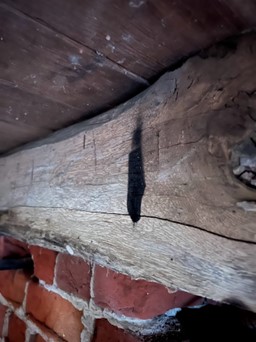
Scorch Marks: These burn marks were created by holding a taper or candle against the timber, purposefully exposing it to fire, thereby protecting the house from falling victim to a fire, a common occurrence during those times. These burn marks would then be gouged out and smoothed with a finger, creating a teardrop effect. The superstition at that time was to fight fire with fire. We have counted six of these tear-drop shaped burn marks in the cellar at Timberneck, mostly along the main support beam that runs under the wall separating the entry hall from the parlor. This beam would have been one of the first to be set in place during the construction of the house.

Marian marks: These appear as two V’s intertwined together, sometimes looking like an “M” or “W”. These are rooted in Christianity and are believed to mean Virgo Virginum or Virgin of Virgins, as in Mary, mother of Jesus. By using this mark, one was invoking the protection of the Virgin Mary over their home. In some cases, the “M” is combined with the letter “A” to create Ave Maria. We have found potential Marian marks in the cellar, on the fireplace mantle in the dining room, on the banister upstairs and on the front door of the 1850s addition at Timberneck.
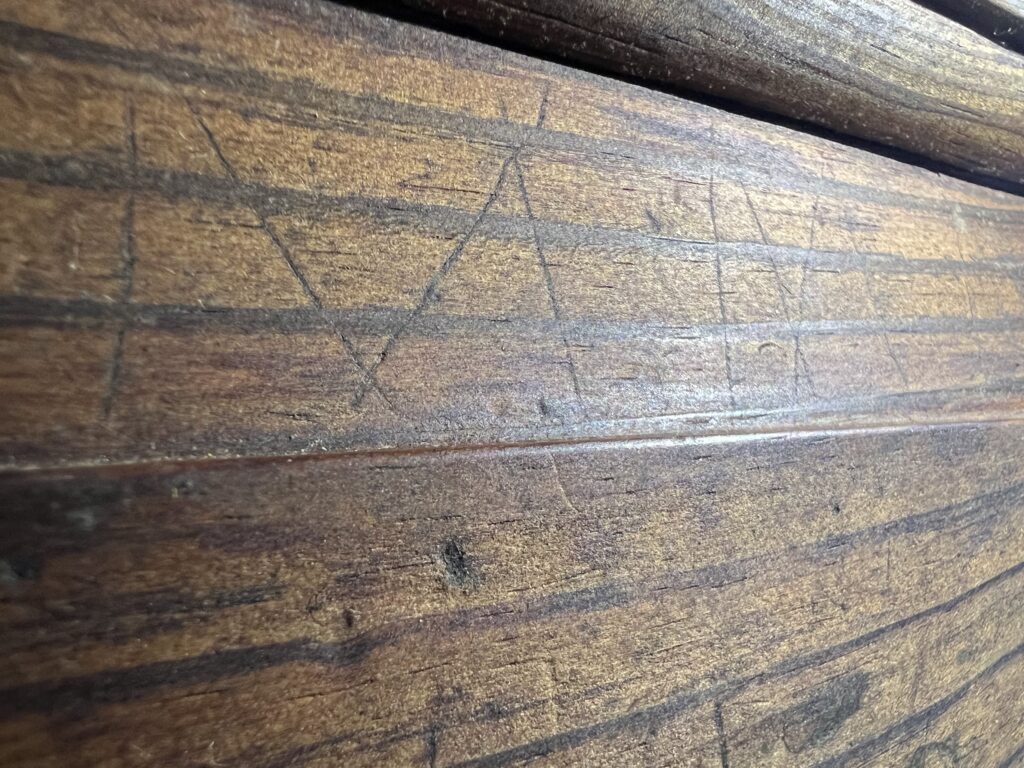
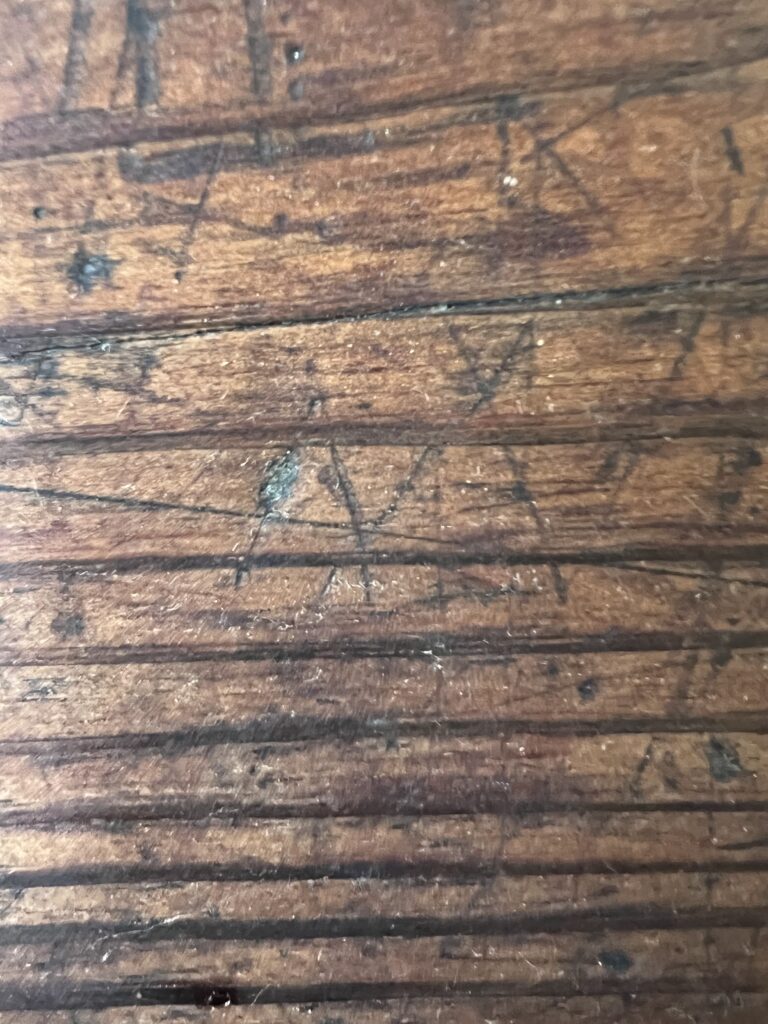
Marian marks on the fireplace mantle in the dining room at Timberneck. The top photo is a line of three “M”’s in a row. Another line of three “M”’s is repeated in another place on the same mantle. In the bottom photo “X”’s that may be interpreted as crosses appear on the same mantle, as well as on the front door of the 1850s addition. The mantle has scores of marks of varying types. Though now unpainted, the mantle was likely intended to be painted from the beginning, and many of these marks could have been done early on, and then were hidden by layers of paint.
Crosses: In the 1850s addition to Timberneck there are several intertwined crosses scratched into the fireplace mantle on the first floor. These are known as St. Andrew’s crosses. While a typical Christian cross has two short lines crossed at a 90-degree angle, the St. Andrew’s crosses at Timberneck have a slanted cross member resembling the letter “X”, which is common among apotropaic markings. At Timberneck we have seen both intertwined and single St. Andrew’s crosses. In addition to the 1850s fireplace mantle, this mark has been found on the exterior of the 1850s front door, the 1790s dining room fireplace mantle and on a door in the 1790s cellar.
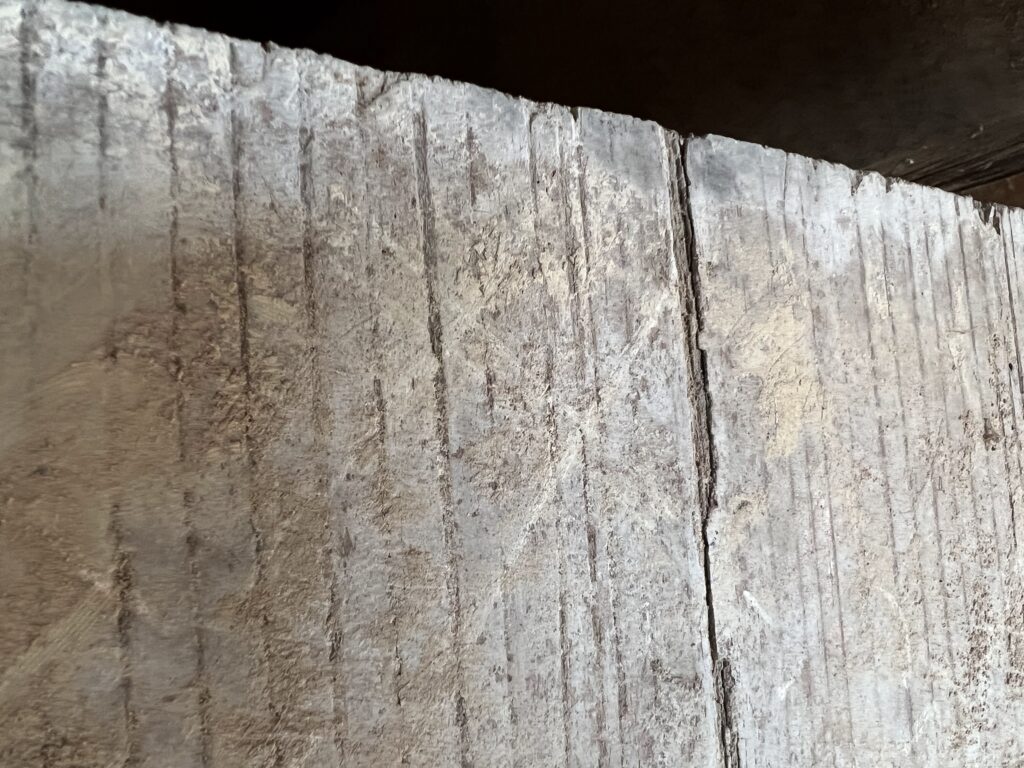
These are just of the few of the potential apotropaic symbols found inside the Timberneck house. There were many common superstitions observed in the 18th and 19th centuries when Timberneck was being built, including the hanging of a horseshoe over the door and immurement, which is the practice of burying or concealing an item, such as a shoe, in the structure of a house during construction. Other practices included the burying of a dead cat under the house to ward off evil spirits, a practice begun in England, while the Irish preferred to bury a horse skull. Locally, Stratford Hall has an example of a “witch’s’ bottle” which is a buried bottle holding nails or other materials from the house.
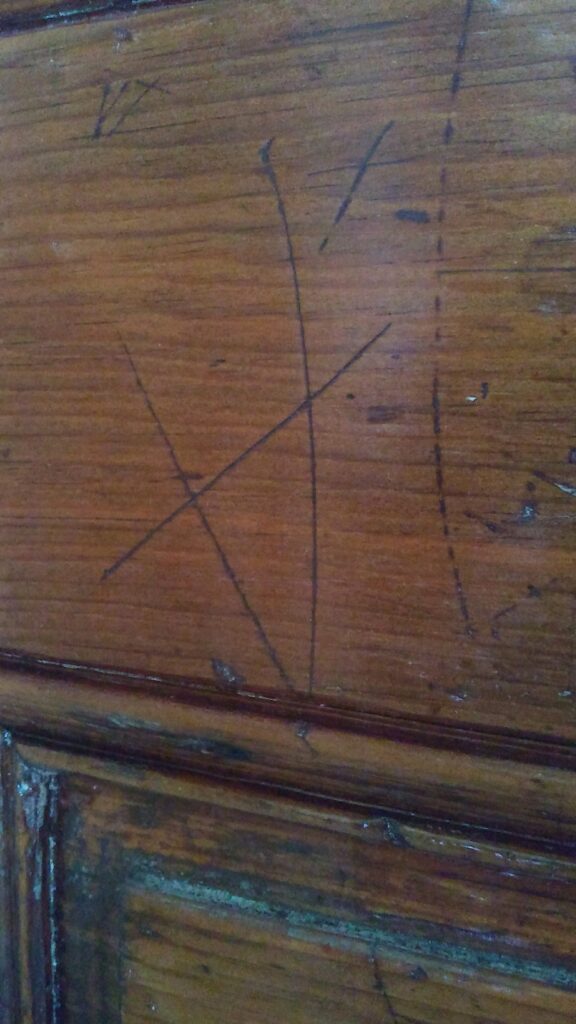
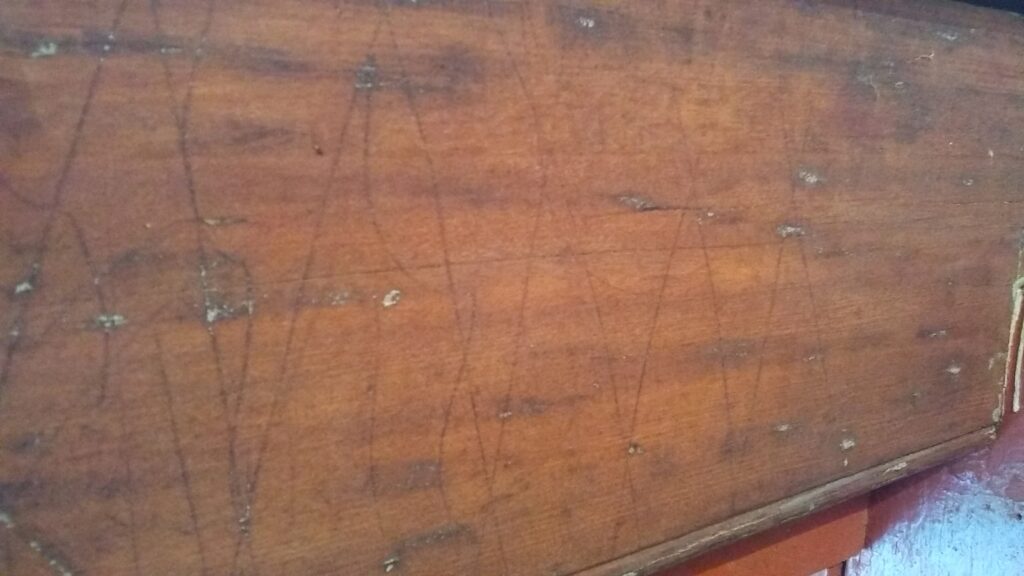
Many of the marks mentioned here were likely added to the house during construction and may have been intended to be concealed, either by paint on the mantles and doors, or because they were placed in the dimly lit cellar, and are only now coming to light. Many other marks at Timberneck tell stories about later residents, visitors, and workers. Names and initials of Catlett family members have been found etched on doors, window sills, and window panes. A note about bacon storage was found on the attic door, tally marks for counting unidentified objects have been found in several places. Many people at Timberneck literally left their mark on the building.
Restoration work on the house will continue soon and we know we will have many more discoveries that will teach us about the people who lived, worked, and died at Timberneck over the last 230 years. It is these discoveries that keep many of us coming back to volunteer, waiting to see what the house will reveal to us.
Timberneck is open to the public for tours each Tuesday from 10 am – 4 pm and the second and fourth Saturday of each month from 10 am – 2 pm from April through October. We also welcome volunteers to help as docents. If you’re interested, please contact our outreach coordinator, Rachel Boyd, at outreach@fairfieldfoundation.org.
References
Clarke, David Marks. “Shura – Sheffield Hallam University Research Archive.” Marks of the Witch: Britain’s Ritual Protection Symbols. Accessed January 18, 2023. https://shura.shu.ac.uk/26362/1/036_FT392.pdf.
Fairey, Charles. “Protective Devices, Apotropaic Symbols and Witch Marks.” Charles Fairey – Historian. Accessed January 18, 2023. https://sites.google.com/site/charlesfaireyhistorian/publications/protective-devices-apotropaic-symbols-and-witch-marks?authuser=0.
Historic England “Discovering Witches’ Marks.” Accessed January 18, 2023.
https://historicengland.org.uk/whats-new/features/discovering-witches-marks/
Historic Boston. “Deciphering the Maker’s Marks at the Fowler Clark Epstein Farm.” Accessed January 18, 2023. https://historicboston.org/deciphering-mystery-markings-at-the-fowler-clark-epstein-farm/
Kelly, Caitlin. “The History Hidden in the Walls.” The New York Times. The New York Times, January 20, 2017. https://www.nytimes.com/2017/01/20/realestate/the-history-hidden-in-the-walls.html.
Morgan, Stuart. “A Belief in the Power of Concealed Shoes.” Accessed January 18, 2023. https://www.satra.com/bulletin/article.php?id=2078.
The National Park Service. “Protecting the Home from Evil.” Accessed January 18, 2023. https://www.nps.gov/articles/000/protecting-the-home-from-evil-spirits.htm
“Ritual Protection Marks in Vernacular Buildings: House Magic.” Witch Marks. Accessed January 18, 2023. http://svbrg.org.uk/witch.php.
Stratford Hall. Accessed January 18, 2023.
https://www.facebook.com/StratfordHall/photos/a.476298065577/10163266992435578/
Von Talee, Ian. “Witch Mark” The Daily Advance. Elizabeth City, NC
https://www.dailyadvance.com/witch-mark/image_ef02105a-9153-5e04-94dc-3fbd871c9629.html
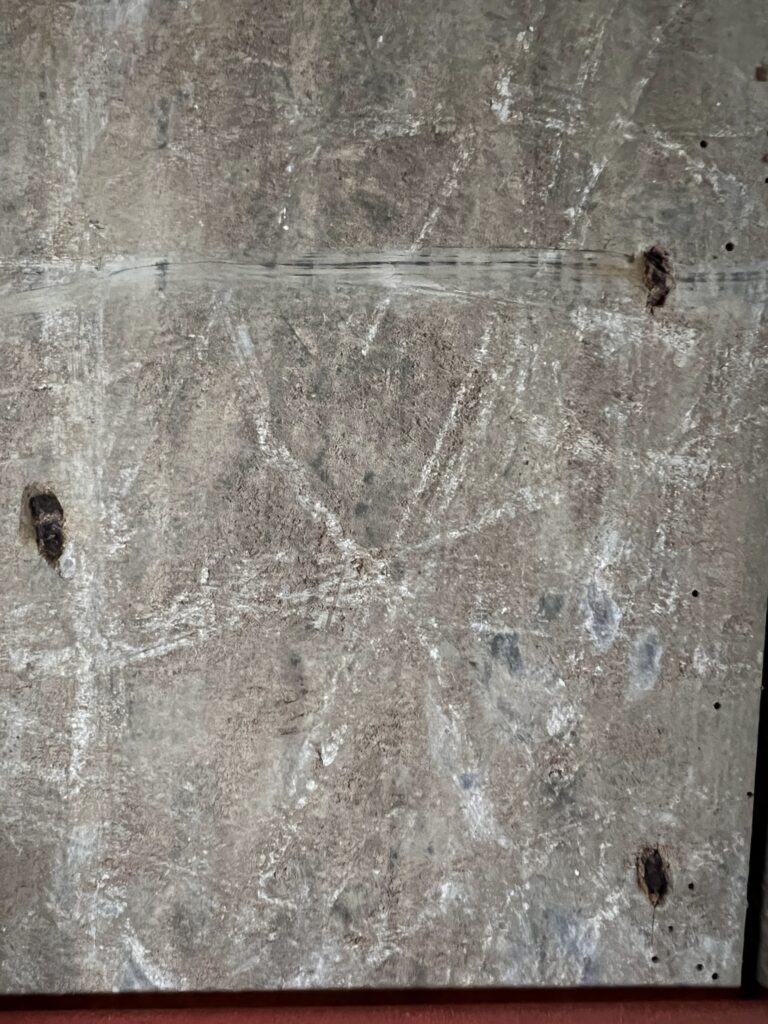
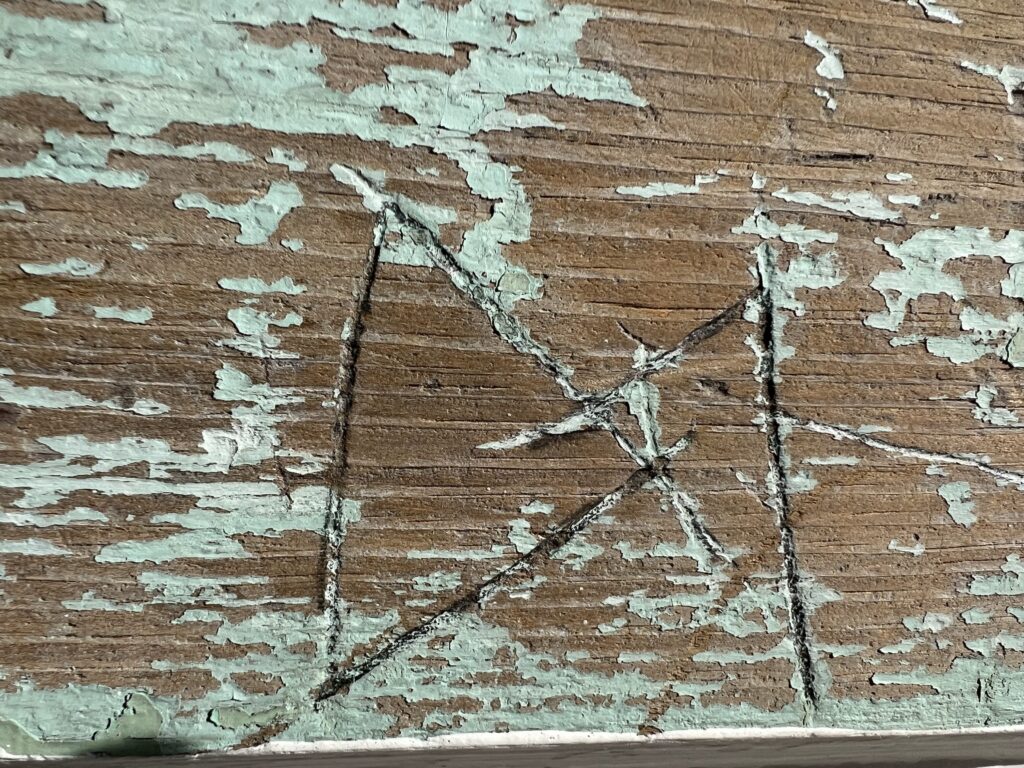
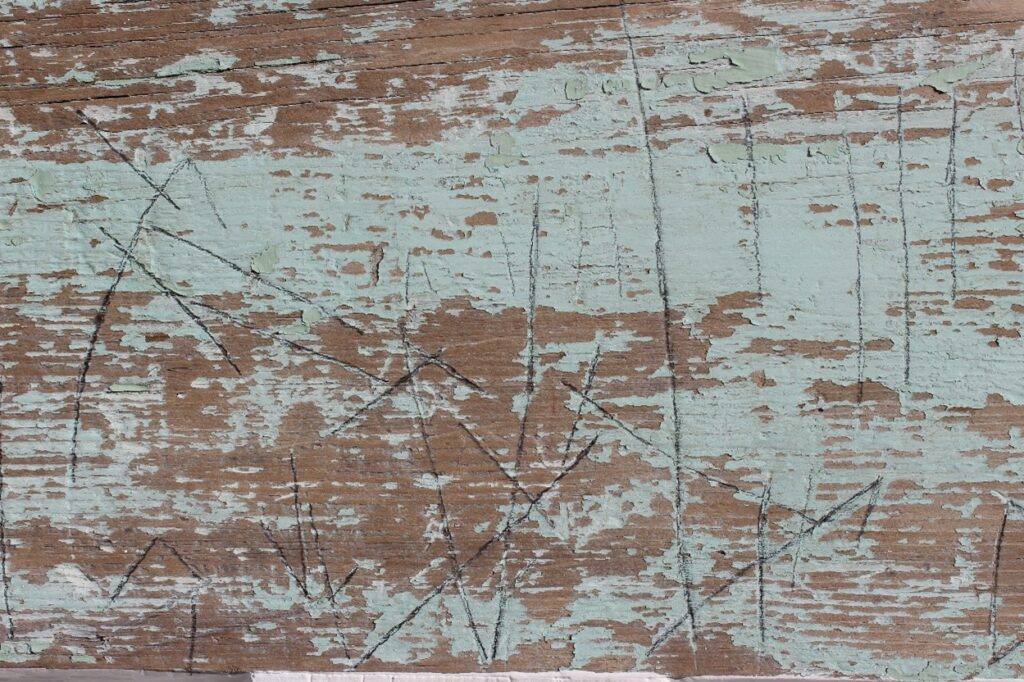
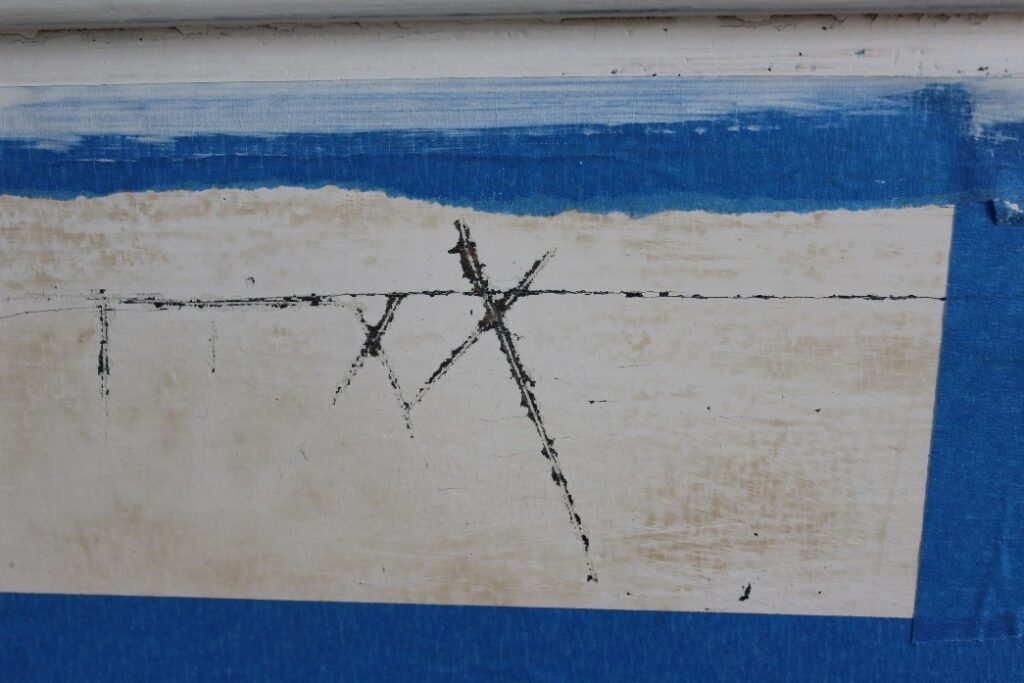


Awesome information! Thank you for sharing such interesting details about the Timberneck House and learning that Tompkins Cottage has some, too!
Tom . . . the article on “witch marks” found by a keen eye during restoration adds a unique flavor to the value of the Timberneck house to Virginia history. When in Va. from Fl. for my 50th Elkton HS reunion in 2015, my wife and I, were privileged you took us to see this house and property on the York River before you were able to bring it into the undertakings of the Fairfield Foundation. It is all very impressive! Chris & Carol Karow